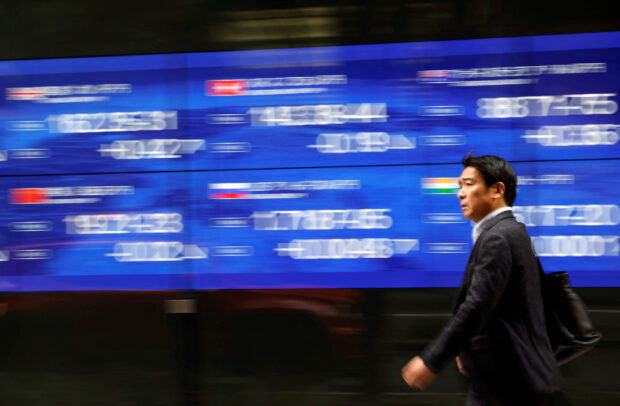
A passerby walks past an electric monitor displaying various countries’ stock price index outside a bank in Tokyo, Japan, March 22, 2023. REUTERS/Issei Kato/File photo
SINGAPORE – Asian shares were set on Friday to snap a three-week losing streak, while investors awaited a key reading on U.S. inflation later in the day to gauge the outlook for U.S. rates.
MSCI’s broadest index of Asia-Pacific shares outside Japan held broadly steady and was on track for a weekly gain of 2 percent.
Trading was thinned with Australia out on a holiday.
Chinese stocks looked set to end the week on a strong footing as a wave of policy support from Beijing restored fragile investor confidence and put a floor under its sliding stock market.
READ: Chinese shares lead gains in Asia on report of market rescue plan
The blue-chip index rose 0.03 percent and was eyeing a 2-percent weekly gain, while the Shanghai Composite edged 0.3 percent higher, putting it on track for a 3-percent weekly rise, its largest since July 2023.
Hong Kong’s Hang Seng Index eased 0.41percent, but was still more than 5percent higher for the week, also its best performance since last July.
In an attempt to shore up its fragile economic recovery, China’s central bank announced a deep cut to bank reserves on Wednesday, in a move that will inject about $140 billion of cash into the banking system.
Those came a day after Bloomberg News reported Chinese authorities are seeking to mobilize about 2 trillion yuan ($278.98 billion), mainly from the offshore accounts of Chinese state-owned enterprises, as part of a stabilization fund to buy shares.
“We remain cautious on China, in line with our view for several years,” said John Pinkel, a partner and portfolio manager at Indus Capital.
READ: China to cut banks’ reserve requirements to boost economy
“We see evidence of selling induced by structured ‘snowball’ products, especially from onshore China sources. This is blending with selling driven by fund closures as well as ongoing uncertainty about Beijing’s commitment to markets… It looks like some investors are giving up on the market.”
Elsewhere, Japan’s Nikkei slid 1percent, retreating from a 34-year high hit at the start of the week, as bets ramped up that the Bank of Japan (BOJ) could soon exit its massive stimulus.
BOJ policymakers agreed to further debate the timing of an exit from its ultra-loose monetary policy, and the appropriate pace of interest rate hikes thereafter, minutes of their December meeting showed on Friday.
Separate data on Friday meanwhile showed core inflation in Tokyo slowed below the central bank’s 2 percent target to hit the lowest level in nearly two years.
Earlier in the week, the BOJ stood pat on its ultra-easy monetary settings, but signaled its growing conviction that conditions for phasing out its huge stimulus were falling into place.
Those expectations helped the yen firm slightly to last stand at 147.56 per dollar.
“The overall message is that the BOJ is getting closer to pulling the trigger on calling a first rate hike,” said Joy Yang, head of Asian economic research at Point72.
European Central Bank (ECB) policymakers likewise kept interest rates steady on Thursday, as expected, and reaffirmed their commitment to fighting inflation.
READ: European Central Bank leaves key interest rate at a record high
However, four sources told Reuters that the ECB was open to a change in its rhetoric at the next meeting, paving the way for an interest rate cut possibly in June, if upcoming data confirms inflation has been vanquished.
The euro eased 0.05 percent to $1.0840 and was on track to end the week with a 0.5-percent loss.
U.S. resilience
In the broader market, focus was on the release of the personal consumption expenditures (PCE) price index later on Friday, with expectations for the so-called core PCE price index – the Federal Reserve’s preferred measure of inflation – to rise 3 percent on an annual basis.
Data on Thursday showed the U.S. economy grew faster than expected in the fourth quarter amid strong consumer spending, shrugging off dire predictions of a recession in the world’s largest economy.
“This release shows further resilience in U.S. growth,” said David Doyle, Macquarie’s head of economics.
“While challenges remain ahead that suggest weaker activity, there were encouraging developments.”
U.S. Treasury yields slipped in the wake of the report which also showed inflation pressures subsiding further, with the benchmark 10-year yield last at 4.1126 percent.
The two-year yield, which closely reflects near-term interest rate expectations, eased 3 basis points to 4.2850 percent.
In currencies, the U.S. dollar drew support from the strong GDP data, pushing sterling down 0.07 percent to $1.2702. The Aussie dipped 0.05 percent to $0.6582.
Oil prices eased slightly after settling roughly 3 percent higher in the previous session, as tensions in the Red Sea continued to pose a threat to global trade.
Brent futures dipped 0.4 percent to $82.11 a barrel. U.S. crude eased 0.57 percent to $76.92 per barrel.
Gold last bought $2,021.50 an ounce.
($1=7.1690 Chinese yuan renminbi)

